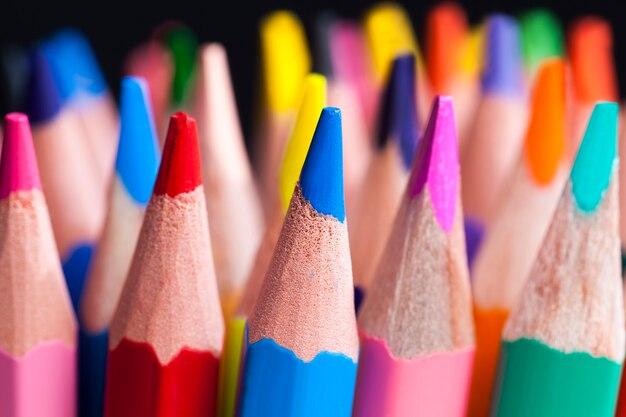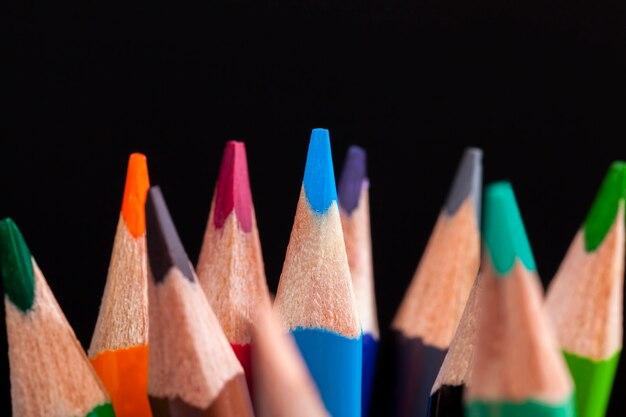In the world of writing and drawing, pencils have been an essential tool for centuries. But have you ever wondered about the composition of pencil “lead” and if it really contains lead? In this blog post, we will explore the fascinating history and evolution of pencil manufacturing. We’ll answer common questions like when lead pencils were first used, when they stopped putting actual lead in pencils, and what materials are used in pencil cores today.
If you’ve ever been concerned about the potential risks of using pencils or wondered why people used to lick the pencil “lead,” we’ve got you covered. We’ll also delve into the symptoms of lead poisoning, whether colored pencils ever contained lead, and what materials are used as a substitute for lead in modern pencils. So sit back, relax, and join us on this journey to uncover the truth about the composition of pencils and when they stopped putting lead in them.
Let’s dive in and discover the surprising facts behind one of our most beloved and versatile writing tools!
When Did They Stop Putting Lead In Pencils
Have you ever wondered when lead pencils stopped having actual lead in them? Well, grab your trusty graphite pencil and join me on a fascinating journey through the history of pencil manufacturing. Spoiler alert: lead pencils never actually contained lead.
The Misnomer: Lead Pencils
Contrary to popular belief, lead pencils have never contained lead. The name can be traced back to the Roman era when lead styluses were used to write on wax tablets. However, in the 16th century, a major breakthrough occurred in the world of writing implements.
The 16th Century Renaissance
In the mid-1500s, an enormous graphite deposit was discovered in Borrowdale, England. This mineral, initially mistaken for lead, was found to be perfect for creating a smooth and durable writing tool. Thus, the “lead pencil” was born, even though it contained no actual lead. Craftsmen encased graphite in wooden dowels, creating a reliable and easily sharpened writing instrument.
The Evolution of Pencils
As time went on, the simple graphite-pencil design evolved. In the 18th century, a French scientist named Nicolas-Jacques Conté developed a method to mix powdered graphite with clay to create a more versatile and longer-lasting pencil. This innovation allowed for different degrees of hardness in pencils, enabling artists and writers to choose the perfect tool for their needs.
Moving Towards Modernity
Fast forward to the 19th century when the industrial revolution kicked into high gear. Pencil production became mechanized, and manufacturers began experimenting with various materials to encase the graphite cores. Wood, which had been the go-to choice, started facing competition from other materials like metal, plastic, and even recycled newspaper.
The Transition Away from Graphite
In the early 20th century, concerns arose about the potential health risks associated with prolonged exposure to graphite dust. As a result, manufacturers started transitioning to a safer alternative: non-toxic clay and graphite composite cores. This switch effectively eliminated any trace of lead from pencil production, making them even safer for everyday use.
Welcome to the Present
Nowadays, pencils are typically made using a combination of graphite, clay, and wax. This formula ensures a smooth writing experience while maintaining durability. The absence of lead not only helps preserve our health but also prevents any confusion regarding the composition of this beloved writing tool.
So, the next time someone mentions “lead pencils,” you can impress them with the historical tidbit that they’ve never contained any lead at all. It’s remarkable how misconceptions can persist through the ages. Now, go forth and write your heart out with your trusty, lead-free pencil!
FAQ: When Did They Stop Putting Lead in Pencils
What Pencil Has the Darkest Lead
When it comes to dark lead, the undisputed champion is the classic 2B pencil. With its rich, velvety darkness, the 2B pencil is the go-to choice for artists, writers, and doodlers alike. Whether you’re sketching a masterpiece or jotting down notes, the 2B pencil will ensure your lines are bold and expressive.
What Happens If You Lick Lead
Well, besides earning you a few strange looks, licking lead isn’t really the best idea. While a quick lick of a pencil won’t cause any immediate harm, prolonged exposure to lead can lead to serious health issues. It’s always best to keep pencils in your hand, not your mouth!
Is Pencil Lead Pure Graphite
Contrary to popular belief, pencil “lead” is not made of lead at all! In fact, it’s made primarily of graphite, mixed with clay and other additives to give it strength and smoothness. So rest assured, your favorite writing tool is completely lead-free.
Are All Pencils Lead-Free
Yes, indeed! Modern pencils are entirely lead-free. The use of actual lead in pencils was discontinued many years ago for safety reasons. So whether you’re using a graphite pencil, a colored pencil, or even a mechanical pencil, you can write and draw without worrying about lead exposure.
Do Pencils Still Contain Lead
Nope! As mentioned earlier, pencils no longer contain lead. The graphite used in pencils is non-toxic and perfectly safe for everyday use. So go ahead and get creative with your pencil – just keep it on paper and away from your taste buds!
Can You Get Lead Poisoning from Eating Pencil Lead
Eating pencil lead? That’s not exactly a recommended snack! But don’t worry, munching on a pencil won’t lead to lead poisoning. Remember, modern pencils contain graphite, not lead. However, it’s still best to stick to edible treats if you’re feeling peckish.
What Happens If Lead Gets in Your Blood
If lead were to somehow find its way into your bloodstream, it can have serious health consequences. Lead poisoning can lead to various symptoms, including abdominal pain, nausea, fatigue, and even cognitive issues. That’s why it’s important to avoid contact with lead in any form.
Are Pencils Made in Australia
While Australia is known for its stunning landscapes and unique wildlife, pencil production isn’t exactly one of its claim to fame. Pencils are produced in various countries around the world, including the United States, Germany, China, and many others. So you never know where your trusty pencil was born!
What Are the Symptoms of Lead Poisoning
The symptoms of lead poisoning can vary but may include headaches, irritability, memory loss, muscle weakness, and difficulties with concentration. If you suspect you may have been exposed to lead, it’s essential to seek medical attention to prevent any further complications.
Is Pencil Lead Poisonous to Dogs
While pencils are generally safe for human use, the same cannot be said for our furry friends. Pencil lead can be toxic to dogs, so it’s important to keep them away from chewed-up pencil bits or even entire pencils. Stick to dog-friendly toys instead – they’ll thank you for it!
What Products Use Lead
Lead used to be quite common in various products, including paint, gasoline, and even plumbing. However, strict regulations have been put in place to limit the use of lead due to its harmful effects. Nowadays, you’re more likely to find lead in old products rather than in everyday items.
What Happens If We Eat Pencil
Let’s just say it’s not a recipe for success! Eating pencils, apart from being quite uncomfortable, can lead to digestive issues. Pencil parts are not meant to be ingested and can cause blockages in your digestive system. Stick to regular food – it’s much tastier and safer!
How Much Lead Is Lethal
Even small amounts of lead can be harmful, especially to children and pregnant women. There is no safe level of lead exposure, and any amount can have detrimental effects on health. That’s why it’s crucial to avoid contact with lead-containing substances.
When Did They Stop Using Lead in Pencils
Lead was phased out from pencils many years ago, in the early 20th century. The switch from lead to graphite was prompted by an increased understanding of the dangers of lead poisoning. So, rest assured, any pencil you pick up today is free from this hazardous material.
Do Old Colored Pencils Have Lead
Colored pencils, like regular pencils, do not contain actual lead. Instead, they use a wax or oil-based binder mixed with pigments to create vibrant colors. So even if you stumble upon a vintage set of colored pencils, rest easy knowing that they do not contain any lead.
When Were Lead Pencils Used
Lead pencils, as the name suggests, were once made with actual lead. This practice dates back several hundred years, with historical records indicating the use of lead pencils as early as the 16th century. Fortunately, advancements in materials and technology have brought us safer alternatives.
Why Did They Lick the Pencil Lead
Ah, yes, the age-old habit of licking the tip of a pencil! While the exact origins of this peculiar behavior are unclear, it’s believed that licking the lead (back when pencils actually had lead) helped to soften it, making it easier to write or draw with. However, times have changed, and licking a modern pencil won’t have the same effect. So, it’s best to leave that tradition in the past!
Is It Bad to Have Pencil Graphite in Your Hand
Having pencil graphite on your hands is usually harmless. The graphite used in modern pencils is non-toxic and can be easily washed off with soap and water. However, prolonged exposure to graphite dust may cause minor irritation, so it’s best to keep your hands, and your face, away from the graphite cloud.
What Is Used in Pencils Instead of Lead
In place of lead, today’s pencils use graphite as the core material. Graphite is a form of carbon that leaves a dark mark when applied to a surface. To give the graphite core strength and durability, it is mixed with clay and other additives. This combination allows for smooth writing and drawing without any harmful lead content.
Do Bic Pencils Have Lead
Bic pencils, like other modern pencils, do not contain lead. They are manufactured with graphite as the core material. Bic pencils are known for their reliability and affordability, offering a smooth writing experience without any risk of lead exposure.
Did They Have Pencils in the 1800s
Absolutely! Pencils have been around for centuries and were indeed present during the 1800s. Although the materials and manufacturing processes have evolved over time, the fundamental idea of a pencil remains unchanged. So, even during the time of horse-drawn carriages and quill pens, people relied on the trusty pencil to put their thoughts to paper.

